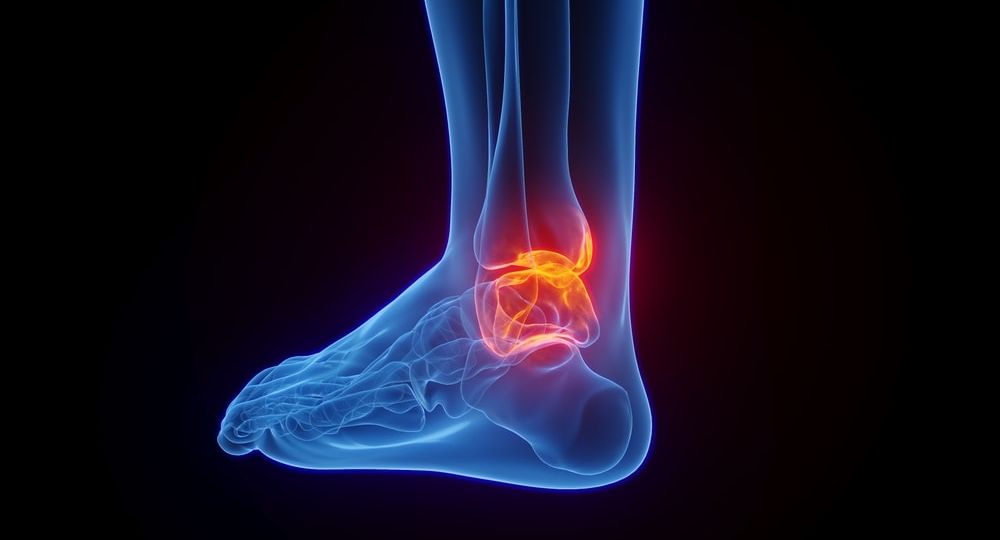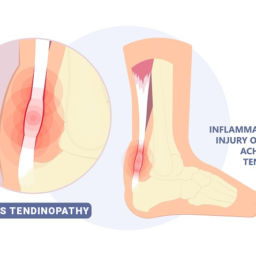
What is Ankle Impingement?
Ankle impingement refers to a condition characterized by pain and limited range of motion in the ankle joint. It occurs when there is compression or pinching of the soft tissues or bone structures within the ankle during certain movements. This can lead to discomfort and inflammation in the joint.
Ankle impingement consists of two types – the first is anterior impingement and the second is, posterior impingement. Anterior impingement, also known as “athlete’s ankle” or “footballer’s ankle,” involves the compression of structures at the front of the ankle, typically caused by repetitive ankle dorsiflexion or forced plantar flexion. Posterior impingement, on the other hand, involves compression at the back of the ankle, often caused by excessive plantar flexion.
Common causes of ankle impingement include previous ankle injuries, repetitive stress on the joint, bone spurs, or structural abnormalities in the ankle joint. Symptoms may include pain, stiffness, swelling, and a decreased range of motion.
Anterior & Posterior Ankle Impingement Syndrome
Anterior and posterior ankle impingement syndrome are conditions characterized by pain and limited range of motion in the ankle joint due to compression or pinching of structures at the front or back of the ankle, respectively.
Anterior ankle impingement syndrome typically occurs when there is repetitive compression of the soft tissues or bone structures at the front of the ankle. This can be caused by activities that involve forceful dorsiflexion (bringing the foot upwards) or repetitive ankle sprains. Over time, this can lead to inflammation, pain, and a decreased ability to fully flex or extend the ankle.
Posterior ankle impingement syndrome, on the other hand, involves compression of the soft tissues or bone structures at the back of the ankle, often resulting from repetitive plantar flexion (pointing the foot downwards). This can be seen in activities that require frequent and forceful push-off movements, such as ballet or sprinting. The compression can cause pain and limited ankle motion, especially during activities that involve forced plantar flexion.
Treatment for anterior and posterior ankle impingement syndromes may initially involve conservative measures such as rest, ice, physical therapy exercises, and anti-inflammatory medications to reduce pain and inflammation. If symptoms persist or worsen, further interventions may be considered. These can include corticosteroid injections, orthotics, activity modifications, and in severe cases, surgical procedures to remove bony abnormalities or repair damaged tissues.
What are the causes and Main Symptoms of Posteromedial Ligament?
The posteromedial ligament, also known as the deltoid ligament, is a strong band of connective tissue located on the inner side of the ankle. It helps stabilize the ankle joint and prevents excessive inward rolling or eversion of the foot. When the posteromedial ligament is injured or damaged, it can lead to a condition known as posteromedial ligament injury or deltoid ligament injury.
The main causes of posteromedial ligament injury include:
- Ankle sprains: The ligament can be stretched or torn when the ankle is forcefully twisted or rolled inwards, commonly occurring during activities that involve sudden changes in direction or uneven surfaces.
- Trauma or impact: Direct trauma or a forceful blow to the inner side of the ankle can injure the posteromedial ligament.
The primary symptoms of a posteromedial ligament injury may include:
- Pain and tenderness: There is typically pain along the inner aspect of the ankle, which worsens with weight-bearing activities or when the foot is turned inwards.
- Swelling and bruising: The injured area may become swollen and show signs of bruising due to bleeding or inflammation.
- Instability: Ankle instability or a feeling of giving way may occur, particularly during activities that stress the ligament.
- Limited range of motion: Movements that involve inward rotation or inversion of the foot may be restricted or painful.
How is posterior ankle impingement diagnosed?
Diagnosing posterior ankle impingement involves a comprehensive evaluation by a healthcare professional, typically a podiatrist or orthopedic specialist. The diagnostic process may include the following:
- Medical history: The doctor will discuss your symptoms, previous ankle injuries, and any relevant medical conditions to understand the context of your condition.
- Physical examination: The healthcare professional will perform a thorough physical examination of your ankle, assessing for pain, swelling, tenderness, and range of motion. They may also evaluate your foot and ankle alignment and perform specific maneuvers to reproduce symptoms.
- Imaging tests: X-rays may be ordered to assess for any bony abnormalities, such as bone spurs or joint degeneration, which may contribute to the impingement. Magnetic resonance imaging (MRI) or ultrasound may be used to evaluate soft tissues, including ligaments, tendons, and joint structures, to assess for inflammation or other structural abnormalities.
- Diagnostic injection: In some cases, a diagnostic injection may be utilized to confirm the source of pain. An anesthetic or corticosteroid can be injected into the affected area to temporarily numb or reduce inflammation, providing relief if the pain is associated with impingement.
Based on the findings from the evaluation, physical examination, and imaging studies, the healthcare professional can make a definitive diagnosis of posterior ankle impingement. This diagnosis will guide the treatment plan and determine the most appropriate interventions to alleviate symptoms and improve ankle function.
It is important to consult with a qualified healthcare professional for an accurate diagnosis and individualized treatment approach tailored to your specific condition.
What is the recovery time for posterior ankle impingement?
The recovery time for ankle impingement can vary depending on several factors, including the severity of the impingement, individual healing abilities, and the chosen treatment approach. In general, the recovery time for ankle impingement can range from a few weeks to several months.
For those that find themselves having cases of ankle impingement, conservative treatments come to their rescue. Rest, physical therapy exercises, and anti-inflammatory medications may be sufficient. In such cases, individuals can often experience relief and return to their regular activities within a few weeks.
For more severe cases or when conservative treatments are ineffective, surgical intervention may be required. The recovery time following ankle impingement surgery can vary but may typically involve a longer rehabilitation period. It can take several weeks for surgical incisions to heal, and physical therapy and gradual rehabilitation exercises may be necessary to restore ankle strength, flexibility, and function. Full recovery from surgery may take several months.
It is important to note that the recovery process is individual and may be influenced by various factors. Compliance with rehabilitation protocols, following the guidance of healthcare professionals, and adopting lifestyle modifications recommended by your healthcare team can contribute to a smoother and more successful recovery.
To get a more accurate estimate of recovery time for ankle impingement, it is advisable to consult with a healthcare professional who can evaluate your specific condition and provide personalized insights based on your circumstances. Certified Foot and Ankle Specialists has clinical locations in the Fort Myers, Tampa, Fort Lauderdale, West Plam Beach and Vero Beach area.








